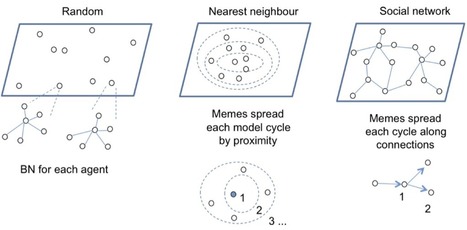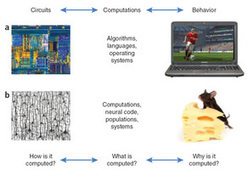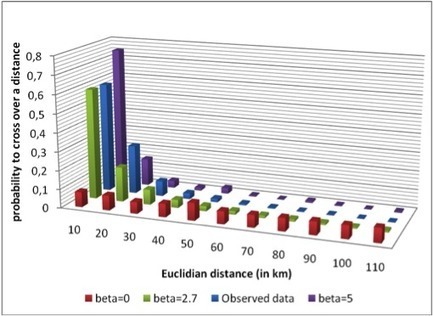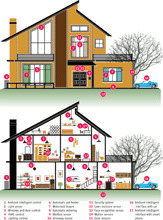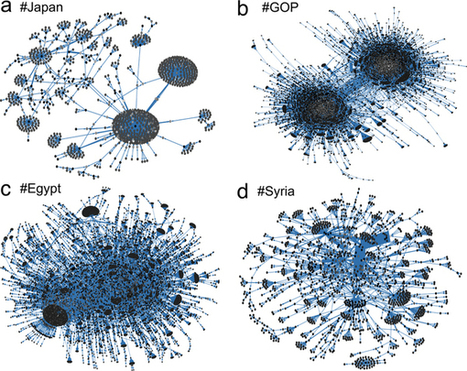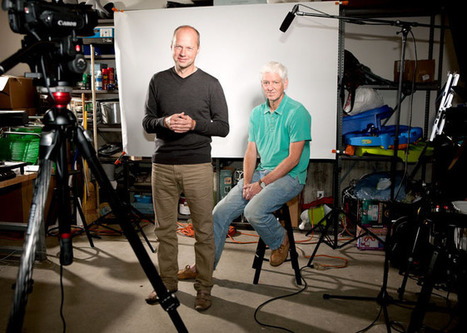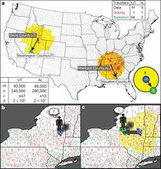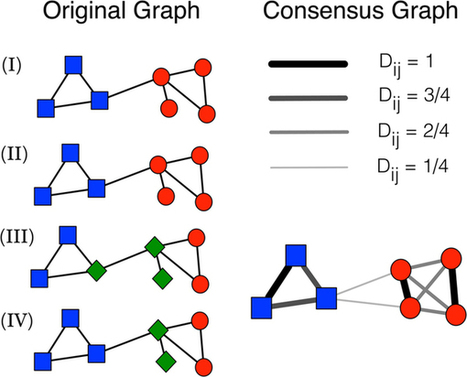 Your new post is loading...
 Your new post is loading...
We introduce a future orientation index to quantify the degree to which Internet users worldwide seek more information about years in the future than years in the past. We analyse Google logs and find a striking correlation between the country's GDP and the predisposition of its inhabitants to look forward. Quantifying the Advantage of Looking Forward Tobias Preis, Helen Susannah Moat, H. Eugene Stanley & Steven R. Bishop
Scientific Reports 2, Article number: 350 doi:10.1038/srep00350
"On the Internet, we’ve reached a tipping point where more than 50% of all Internet traffic is no longer generated by humans – instead, it's generated by a motley mix of search engine spiders, bots, scrapers, scammers, hackers and, yes, spies. We are no longer talking about the Internet, we are talking about the Bot Net – a “bot-mediated reality” where algorithms and bots influence where we go, how long we spend there and with whom we communicate." This great pick by Sakis Koukouvis goes on to list impressive facts on how the Internet is being controlled by robots. Time to put Human Curation back into the game?
Via Sakis Koukouvis, Guillaume Decugis
The process by which genes and memes influence behaviour is poorly understood. Genes generally may have a strong influence as predispositions directing individuals towards certain behaviours; whereas memes may have a less direct influence as information inputs to cognitive processes determining behaviour. In certain areas of medical science, knowledge has progressed towards approximate quantification of genetic influences, while social psychology can provide models of mimetic influence as the spread of attitudes. This paper describes a computational model integration of genetic and mimetic influences in a healthcare domain. It models mimetic influences of advertising and health awareness messages in populations with genetic predispositions towards obesity; environmental variables influence both gene expression and mimetic force. Sensitivity analysis using the model with different population network structures is used to investigate the relative force of meme spread and influence. Alistair Sutcliffe and Di Wang (2012) Investigating the Relative Influence of Genes and Memes in Healthcare Journal of Artificial Societies and Social Simulation 15 (2) 1

|
Suggested by
Joseph Lizier
|
Common methods of causal inference generate directed acyclic graphs (DAGs) that formalize causal relations between n variables. Given the joint distribution of all these variables, the DAG contains all information about how intervening on one variable would change the distribution of the other n-1 variables. It remains, however, a non-trivial question how to quantify the causal influence of one variable on another one.
Here we propose a measure for causal strength that refers to direct effects and measure the "strength of an arrow" or a set of arrows. It is based on a hypothetical intervention that modifies the joint distribution by cutting the corresponding edge. The causal strength is then the relative entropy distance between the old and the new distribution.
We discuss other measures of causal strength like the average causal effect, transfer entropy and information flow and describe their limitations. We argue that our measure is also more appropriate for time series than the known ones.
Finally, we discuss conceptual problems in defining the strength of indirect effects. Quantifying causal influences Dominik Janzing, David Balduzzi, Moritz Grosse-Wentrup, Bernhard Schoelkopf arXiv:1203.6502
Neuroscience seeks to understand how neural circuits lead to behavior. However, the gap between circuits and behavior is too wide. An intermediate level is one of neural computations, which occur in individual neurons and populations of neurons. Some computations seem to be canonical: repeated and combined in different ways across the brain. To understand neural computations, we must record from a myriad of neurons in multiple brain regions. Understanding computation guides research in the underlying circuits and provides a language for theories of behavior. From circuits to behavior: a bridge too far? Matteo Carandini
Nature Neuroscience 15, 507–509 (2012) doi:10.1038/nn.3043
Published online 27 March 2012
Human mobility and, in particular, commuting patterns have a fundamental role in understanding socio-economic systems. Analysing and modelling the networks formed by commuters, for example, has become a crucial requirement in studying rural areas dynamics and to help decision-making. This paper presents a simple spatial interaction commuting model with only one parameter. The proposed algorithm considers each individual who wants to commute, starting from their residence to all the possible workplaces. The algorithm decides the location of the workplace following the classical rule inspired from the gravity law consisting of a compromise between the job offers and the distance to the job. The further away the job is, the more important the offer should be to be considered for the decision. Inversely, the quantity of offers is not important for the decision when these offers are close by. The presented model provides a simple, yet powerful approach to simulate realistic distributions of commuters for empirical studies with limited data availability. The paper also presents a comparative analysis of the structure of the commuting networks of the four European regions to which we apply our model. The model is calibrated and validated on these regions. The results from the analysis show that the model is very efficient in reproducing most of the statistical properties of the network given by the data sources.
Via David Rodrigues
Individuals spend most of their time in their home or workplace; for many, these places are their sanctuaries. Over the course of the 20th century, technological advances have helped to enhance the comfort and shelter provided by our homes. Insights gained from capturing and modeling behavior in these places may be useful in making our environments more intelligent and responsive to our needs. Recent advances are bringing such “ambient intelligence” in the home closer to reality.
The wide adoption of social media has increased the competition among ideas for our finite attention. We employ a parsimonious agent-based model to study whether such a competition may affect the popularity of different memes, the diversity of information we are exposed to, and the fading of our collective interests for specific topics. Agents share messages on a social network but can only pay attention to a portion of the information they receive. In the emerging dynamics of information diffusion, a few memes go viral while most do not. The predictions of our model are consistent with empirical data from Twitter, a popular microblogging platform. Surprisingly, we can explain the massive heterogeneity in the popularity and persistence of memes as deriving from a combination of the competition for our limited attention and the structure of the social network, without the need to assume different intrinsic values among ideas.
(…) we provide a method to build models of collective dynamics from homing pigeon flight data. We show that our models follow the source dynamics well, and from them we are able to infer that significant collective behavior occurs in pigeon flights. Our results are consistent with the basic principles of previous hypotheses and models that have been proposed. Our approach serves as an initial outline towards the usage of experimental data to construct computational models to understand many complex phenomena with hypothesized collective behavior.
Proteins are remarkable machines of the living systems that show diverse biochemical functions. Biochemical diversity has grown over time via molecular evolution. In order to understand how diversity arose, it is fundamental to understand how the earliest proteins evolved and served as templates for the present diverse proteome. The one sequence - one structure - one function paradigm is being extended to a new view: an ensemble of different conformations in equilibrium can evolve new function and the analysis of inherent structural dynamics is crucial to give a more complete understanding of protein evolution.
Computational modeling and behavioral experimentation suggest that human frontal lobe function is capable of monitoring three or four concurrent behavioral strategies in order to select the most suitable one during decision-making.
Emergence of cooperation in evolutionary prisoner's dilemma game strongly depends on the topology of underlying interaction network. We explore this dependence using community networks with different levels of structural heterogeneity, which are generated by a tunable upper-bound on the total number of links that any vertex can have. We study the effect of community structure on cooperation by analyzing a finite population analogue of the evolutionary replicator dynamics. We find that structural heterogeneity mediates the effect of community structure on cooperation. In the community networks with low level of structural heterogeneity, community structure has negative effect on cooperation. However, the positive effect of community structure on cooperation appears and enhances with increasing structural heterogeneity. Our work may be helpful for understanding the complexity of cooperative behaviors in social networks.
People around the world have gone crazy for this opportunity. Fully two-thirds of my 160,000 classmates live outside the US. There are students in 190 countries—from India and South Korea to New Zealand and the Republic of Azerbaijan. More than 100 volunteers have signed up to translate the lectures into 44 languages, including Bengali. In Iran, where YouTube is blocked, one student cloned the CS221 class website and—with the professors’ permission—began reposting the video files for 1,000 students.
|
Introduced in its contemporary form in 1946 (...) the gravity law is the prevailing framework with which to predict population movement cargo shipping volume and inter-city phone calls, as well as bilateral trade flows between nations. Despite its widespread use, it relies on adjustable parameters that vary from region to region and suffers from known analytic inconsistencies. Here we introduce a stochastic process capturing local mobility decisions that helps us analytically derive commuting and mobility fluxes that require as input only information on the population distribution. The resulting radiation model predicts mobility patterns in good agreement with mobility and transport patterns observed in a wide range of phenomena, from long-term migration patterns to communication volume between different regions. Given its parameter-free nature, the model can be applied in areas where we lack previous mobility measurements, significantly improving the predictive accuracy of most of the phenomena affected by mobility and transport processes. A universal model for mobility and migration patterns Filippo Simini, Marta C. González, Amos Maritan & Albert-László Barabási
Nature 484, 96–100 (05 April 2012) doi:10.1038/nature10856
The importance of adequately modeling credit risk has once again been highlighted in the recent financial crisis. Defaults tend to cluster around times of economic stress due to poor macro-economic conditions, but also by directly triggering each other through contagion. Although credit default swaps have radically altered the dynamics of contagion for more than a decade, models quantifying their impact on systemic risk are still missing. Here, we examine contagion through credit default swaps in a stylized economic network of corporates and financial institutions Derivatives and credit contagion in interconnected networks S. Heisea and R. Kühn Eur. Phys. J. B (2012) 85: 115
This paper illustrates the use of the nonparametric Wald-Wolfowitz test to detect stationarity and ergodicity in agent-based models. A nonparametric test is needed due to the practical impossibility to understand how the random component influences the emergent properties of the model in many agent-based models. Nonparametric tests on real data often lack power and this problem is addressed by applying the Wald-Wolfowitz test to the simulated data. The performance of the tests is evaluated using Monte Carlo simulations of a stochastic process with known properties. It is shown that with appropriate settings the tests can detect non-stationarity and non-ergodicity. Knowing whether a model is ergodic and stationary is essential in order to understand its behavior and the real system it is intended to represent; quantitative analysis of the artificial data helps to acquire such knowledge. Jakob Grazzini (2012) Analysis of the Emergent Properties: Stationarity and Ergodicity Journal of Artificial Societies and Social Simulation 15 (2) 7
-Medical Students, Climate Change And Health -A Multi-Paradigmatic Framework To Manage Adaptation Of Socio-Ecological Systems: Design Considerations For An Andean Eco-Region -Emerging Community Food Production And Pathways For Urban Landscape Transitions -The Land Ethic -Emerging Sustainability: Reflections On Working In Sustainability And Health -Adjacent Opportunities: Change, Change, Change
My view as developed in that post is that debt is central to understanding economic systems, and not just because it has a redistributive element in apportioning losses between creditors and debtors when recession forces credit writedowns. In any event, I think the standard approach of simplifying complex economic systems leads to simplistic models that are inadequate for anyone interested in tail risk.
Via Frédéric Amblard
The idea of ambient intelligence implies an intrinsic link between individuals and their environment, enabling individuals to access and interact with computing artifacts in ways that are intuitive and do not disrupt everyday activities. Given the many different environments encountered as part of everyday life (…) enabling such interaction is a formidable technological challenge. The reward may be an environment that is safer, uses less energy, and responds to the needs of all individuals (…). Recent advances in embedded systems, robotics, and sensor technology suggest that ambient intelligence may indeed be realized (…)
A crowd of pedestrians is a complex system that exhibits a rich variety of self-organized collective behaviours. For instance, when two flows of people are walking in opposite directions in a crowded street, pedestrians spontaneously share the available space by forming lanes of uniform walking directions. This “pedestrian highway” is a typical example of self-organized functional pattern, as it increases the traffic efficiency with no need of external control. In this work, we have conducted a series of laboratory experiments to determine the behavioral mechanisms underlying this pattern. In contrast to previous theoretical predictions, we found that the traffic organization actually alternates in time between well-organized and disorganized states. Our results demonstrate that this unstable dynamics is due to interactions between people walking faster and slower than the average speed of the crowd. While the traffic efficiency is maximized when everybody walks at the same speed, crowd heterogeneity reduces the collective benefits provided by the traffic segregation. This work is a step ahead in understanding the mechanisms of crowd self-organization, and opens the way for the elaboration of management strategies bound to promote smart collective behaviors.
The community structure of complex networks reveals both their organization and hidden relationships among their constituents. Most community detection methods currently available are not deterministic, and their results typically depend on the specific random seeds, initial conditions and tie-break rules adopted for their execution. Consensus clustering is used in data analysis to generate stable results out of a set of partitions delivered by stochastic methods.
In insect colonies, different individuals specialize in different tasks related to colony maintenance and growth. Unveiling why this division of labor evolved and how individuals decide which task to take on is crucial for our understanding of complex group behavior. Here we model the evolution of general behavioral rules for processing environmental signals of task need in social insect colonies, using artificial neural networks.
Many faculty, staff, and students at academic institutions think about starting companies at some point in their careers. As academic funding models change, and how academia views entrepreneurial activity changes, starting companies is likely to happen more frequently. Hence, it is worth considering Ten Simple Rules to contemplate when starting a company while in academia.
This paper deals with the arrow of complexification of engineering. We claim that the complexification of engineering consists in (a) that shift throughout which engineering becomes a science; thus it ceases to be a (mere) praxis or profession; (b) becoming a science, engineering can be considered as one of the sciences of complexity. In reality, the complexification of engineering is the process by which engineering can be studied, achieved, and understood in terms of knowledge, and not of goods and services any longer. Complex engineered systems and bio-inspired engineering are so far the two expressions of a complex engineering.
The elementary cellular automaton following rule 184 can mimic particles flowing in one direction at a constant speed. Therefore, this automaton can model highway traffic qualitatively. In a recent paper, we have incorporated intersections regulated by traffic lights to this model using exclusively elementary cellular automata. In such a paper, however, we only explored a rectangular grid. We now extend our model to more complex scenarios using an hexagonal grid. This extension shows first that our model can readily incorporate multiple-way intersections and hence simulate complex scenarios. In addition, the current extension allows us to study and evaluate the behavior of two different kinds of traffic-light controller for a grid of six-way streets allowing for either two- or three-street intersections: a traffic light that tries to adapt to the amount of traffic (which results in self-organizing traffic lights) and a system of synchronized traffic lights with coordinated rigid periods (sometimes called the “green-wave” method). We observe a tradeoff between system capacity and topological complexity. The green-wave method is unable to cope with the complexity of a higher-capacity scenario, while the self-organizing method is scalable, adapting to the complexity of a scenario and exploiting its maximum capacity. Additionally, in this article, we propose a benchmark, independent of methods and models, to measure the performance of a traffic-light controller comparing it against a theoretical optimum.
|



 Your new post is loading...
Your new post is loading...




